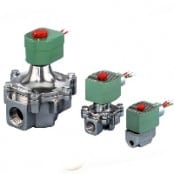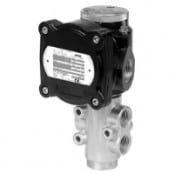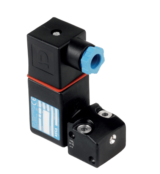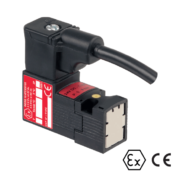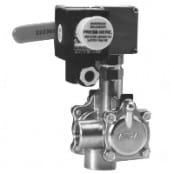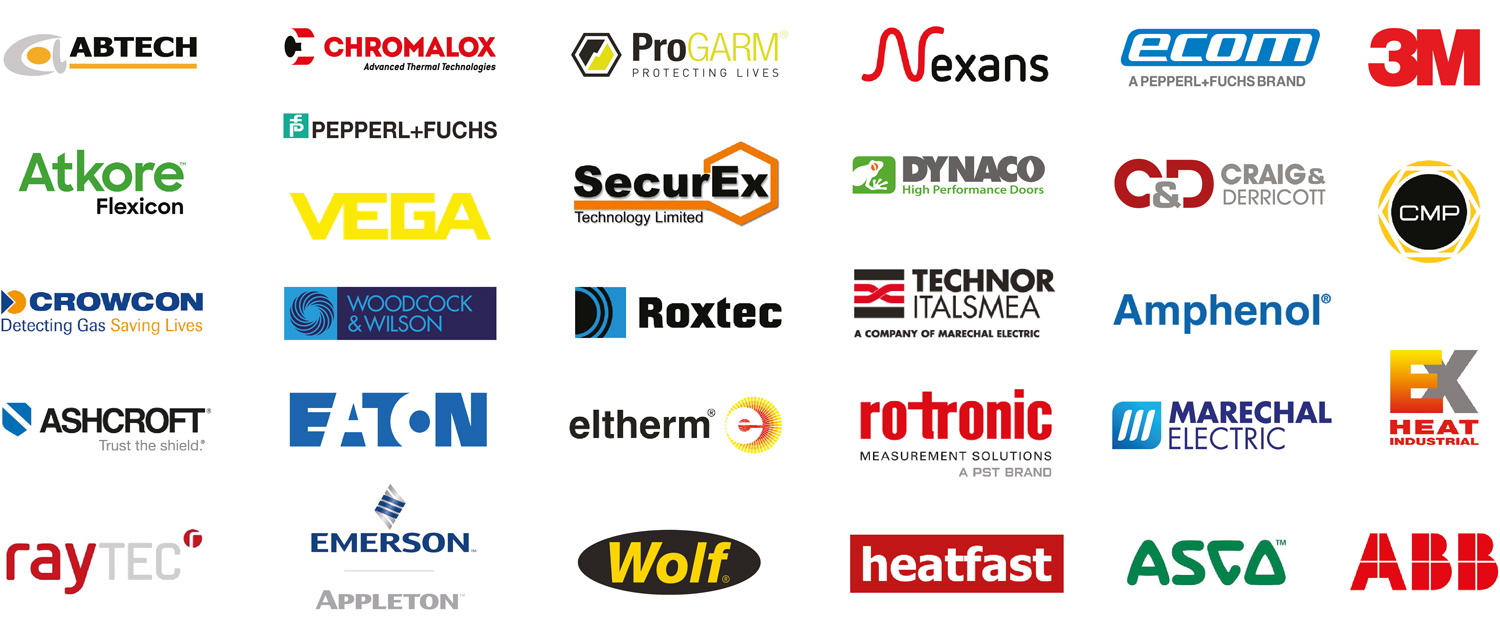Understanding European Versus U.S. Temperature Code Ratings For Solenoid-Operated Valves
Published 07 Jul 2020
by Manny Arceo
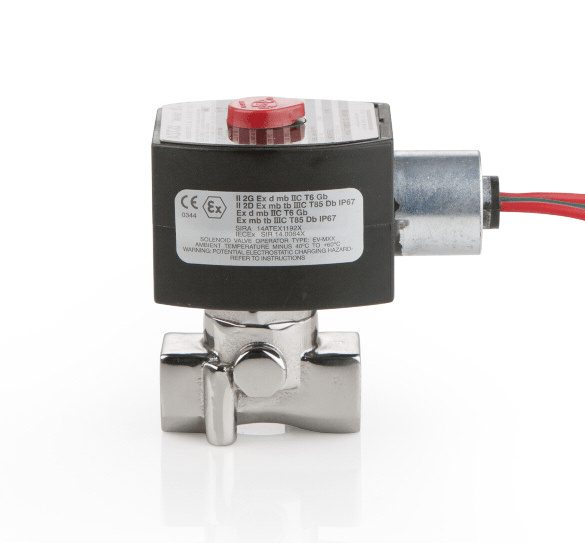
Solenoid Valves
Solenoid valves are a vital component of many process automation systems. Users must depend on these valves to operate flawlessly in hazardous or explosive environments; to comply with safety regulations; and to stay up and running for continuous and safe operation of the process and the plant.
Understanding the differences between valves is critical in specifying and selecting the correct model. This is a useful skill not only for end-user application and process engineers, but also for design engineers employed by original equipment manufacturers (OEMs). However, such understanding can be hard to come by.
Particularly difficult for many buyers to work with, are differences in the temperature ratings of valves. These T-code ratings are assigned by approval agencies in the U.S., Europe, and many other regions worldwide as industrial globalisation increases.
This paper examines and explains the differences among the world’s major temperature ratings for solenoid valves. (Note that the ratings may apply to some other electrical devices as well.)
It should serve as a concise guide to understanding and applying these ratings in order to correctly specify these components.
The advantages of global approvals
As more companies conduct their operations on a global scale, products that have received global ratings and approvals by appropriate standards bodies naturally become more popular. For solenoid valve purchasers, global approvals offer multiple advantages:
- Due to rationalization of parts, a single design/setup can be used in multiple regions.This simplifies end users’ supply chains.
- Users can specify one valve; track one SKU number; and be assured of consistent quality.
- Companies with operations in multiple locations can simplify ordering and stocking of their spare parts and rebuild kits.
- Users can streamline training, operation — and especially maintenance.
- All the above can help to cut costs and reduce inventory efforts.
From the users’ point of view, the ideal approvals regimen would feature one global set of standards emanating from one agency. Or at least one set of common standards across multiple agencies. This may be attained eventually, but not soon.
For the foreseeable future, users will be required to deal with multiple agencies issuing multiple ratings and approvals. Fortunately, some suppliers make it a point to get multiple approvals for the same valve. For example, ASCO valves with EV solenoids recently added ATEX and IECEx approvals to their existing UL- and CSA-approved products.
A valve supplier that obtains multiple approvals certainly aids its users in their global stocking efforts. However, companies specifying and using these valves must deal with multiple temperature codes (T-codes) on each product.
It is important that users interpret these ratings correctly in order to make the right specifying decisions.
The approvals world
For solenoid valve purchasers around the world, key approval agencies with international profiles are UL in the United States, CSA in Canada, and ATEX and IECEx in Europe.
Local agencies — such as NEPSI or INMETRO — typically accept test reports from these four major agencies and use the same standards, often under official cross-certification agreements. (See map below.)
Fortunately, as the map makes clear, local approvals almost invariably follow either U.S. or European methods. For this reason, knowledge of temperature ratings and approvals systems accepted in the U.S. and Europe will serve users well in making almost any valve specifying/purchasing decision.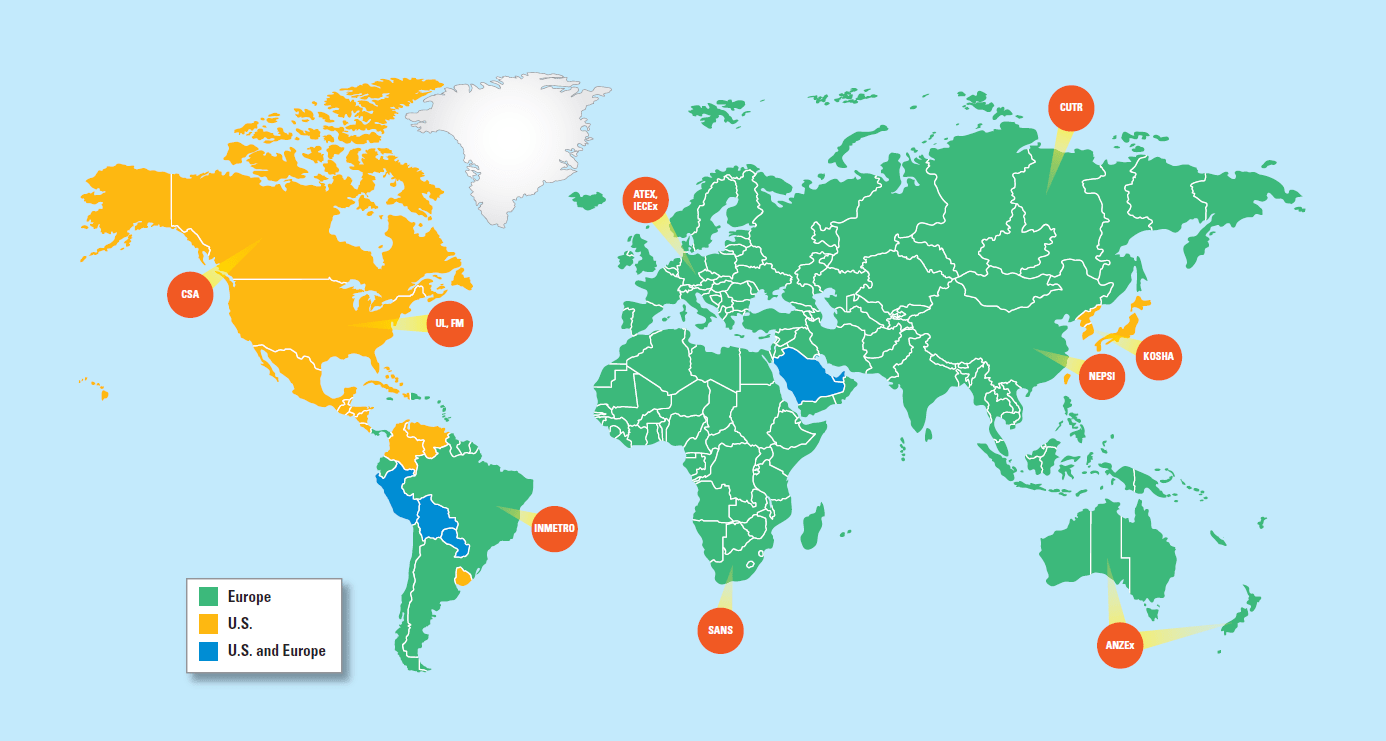
| ANZEx | Australian Program for the Certification of Equipment for Explosive Atmospheres |
| INMETRO | National Institute of Metrology, Quality and Technology |
| CSA | Canadian Standards Association |
| NEPSI | National Supervision and Inspection Center for Explosion Protection and Safety of Instrumentation |
| ATEX | (Devices for Use in) Explosive Atmospheres |
| IECEx | International Electrotechnical Commission System for Certification to Standards Relating to Equipment for Use in Explosive Atmospheres |
| KOSHA | The Korea Occupational Safety and Health Agency |
| CUTR | Customs Union Technical Regulations |
| SANS | South African National Standards |
| UL | Underwriters Laboratories Inc. |
| FM | Factory Mutual |
Approvals from U.S. agencies
In the U.S., approval types are based on area classification. These vary depending on the type of hazardous environment in which a given device can be used. U.S. systems focus on two basic explosion-proof area classifications:
- Class I, Division 1: where flammable gases, vapors, or liquids can exist under normal operating conditions
- Class I, Division 2: areas adjacent to Class I, Division 1 locations, where flammable gases, vapours, or liquids can be present occasionally
Approvals from European agencies
In contrast to the U.S. area classifications above, European systems group their approval types based on the method of protection used for a given device – flameproof enclosure, encapsulate, etc. Users may encounter four popular types of protection methods for valve products.
These methods are designated by the protection methods d, m, e, and i:
| “d” | A component that can ignite an environment containing explosive gas is placed in a metallic enclosure. If the component causes ignition of the explosive gas inside the box, the enclosure will be strong enough to contain the explosion without letting it propagate to the outside environment. This method is considered to offer the best protection in an explosion-proof environment. |
| “m” | A component that can cause ignition (via arcing or sparking) is encapsulated by a compound that prevents the explosive environment from being ignited. Thus potentially explosive gases and component arcing/sparking sources are isolated from one another. |
| “e” | Spacing between electrical parts is strictly controlled, so that a component cannot produce arcs or sparks that might cause ignition in an explosive environment. |
| “i” | Power levels of electrical components are so low that, even under fault conditions, there is not enough energy to produce ignition. An intrinsically safe barrier is required, but a full enclosure is not needed. This is also known as the “intrinsically safe” method. |
Users should develop a basic understanding of these codes to apply them correctly in specifying and/or purchasing solenoid valves.
Note: IECEx vs. ATEX
Temperature code ratings and other standards from Europe may refer to either or both IECEx approvals and ATEX approvals.
IECEx is an industry group standard. It’s the system used by the International Electrotechnical Commission (IEC) for certification to standards relating to equipment for use in explosive atmospheres.
ATEX is a government standard. It’s derived from European Union directives that regulate what equipment and work environments are permissible in an explosive atmosphere.
How are these two different approvals applied to evaluating electrical equipment for purchase or specification? For practical purposes, IECEx and ATEX standards can be understood as essentially identical.
T-codes: defined
A “T-code,” or temperature code, states the maximum surface temperature which a component is able to reach in certain conditions. For the U.S., these are abnormal operating conditions and nominal voltage. For Europe, they are normal operating conditions and 10% over nominal voltage.
Basically, a valve’s T-code offers temperature information that’s critical to the safe operation of the valve. The process industries, including oil and gas, chemicals, power generation, and others, possess many hazardous locations where an explosion could occur and cause extreme damage, as well as personal injury or even loss of life.
For example, oil refineries may carry flammable gases or vapours in ambient air: a textbook case of a hazardous industrial environment.
For safety in such an environment, it is important to determine if any component can become hot enough to ignite those gases or vapours. The minimum temperature at which a gas or vapour will ignite is known as its auto-ignition temperature or AIT. All flammable chemicals have a characteristic AIT.
For rating purposes, the surface temperature of a product such as a solenoid valve must not exceed 80% of the AIT for a specific gas or vapour.
Therefore T-code ratings are assigned to products used in hazardous environments. Their purpose is to help users determine whether a given solenoid valve or other electrical device can be used in a given hazardous application or explosive location without reaching local AIT and causing gases or vapours present in that environment to ignite.
T-codes: compared
Valves sourced from both the U.S. and Europe use similar-looking T-codes to indicate safe upper thermal limits. However, some differences can be found. Maximum temperature limits are the same for both areas — except that in the U.S., the T-codes T2, T3, and T4 are further subdivided (see table below).
In the U.S., codes are based on ambient temperature plus the temperature rise of the valve surface. Here, “temperature rise” indicates the average increase in surface temperature above ambient temperature when the valve is operating.
By contrast, in Europe, codes are based on ambient temperature plus the temperature rise of the valve surface plus a safety margin of 5° C.
| Temperature Code – Europe | Temperature Code – U.S. | Maximum Surface Temperature |
| T1 | T1 | 450°C (842°F) |
| T2 | T2 | 300°C (572°F) |
| T2A | 280°C (536°F) | |
| T2B | 260°C (500°F) | |
| T2C | 230°C (446°F) | |
| T2D | 215°C (415°F) | |
| T3 | T3 | 200°C (392°F) |
| T3A | 180°C (356°F) | |
| T3B | 165°C (329°F) | |
| T3C | 160°C (320°F) | |
| T4 | T4 | 135°C (275°F) |
| T4A | 120°C (248°F) | |
| T5 | T5 | 100°C (212°F) |
| T6 | T6 | 85°C (185°F) |
Again, certain U.S. temperature codes are subdivided, with different temperatures for each. For instance, the European method has only one T2 code, at 300° C (572° F). By contrast, notice that the U.S. method lists ratings from T2 at that temperature through T2A at 280° C (536° F) down to T2D at 215° C (415° F).
To avoid confusion in these or similar circumstances, some product labels state an actual temperature, instead of or in addition to a T-code. So a label may read not just “T6,” but also “85C” or “T85” (meaning maximum surface temp of 85° C) for the greatest clarity.
In both methodologies shown above, the ambient temperature is a significant factor in T-code calculations.
Since the European method adds that extra 5°C, some valve manufacturers label a valve with one maximum ambient temperature rating based on U.S. approvals, and another based on European approvals. Manufacturers often go to the trouble of seeking these multiple approvals to keep the same temperature code and prevent user confusion.
Example: a product label might list a maximum ambient rating of 80° C (T5) under U.S.-type approvals. However, to keep the consistent T5 rating, the same product might also bear European-type approvals where the maximum ambient rating might be listed as 74° C.
Tip: check the maximum ambient temperature rating for the worst case your installation might encounter. If characteristics are otherwise similar, then select your valve according to the lower maximum ambient temperature listed on its label.
T-codes: beyond the label
Markings on a label may have multiple T-codes to try to cover every real-world contingency for the entire range of industrial environments (see Figure 1).
Example: for certain applications in some locations, the maximum ambient temperature of the facility may actually be lower than the rated maximum ambient temperature of the solenoid valve. Since U.S. T-codes, for example, are based on temperature rise plus maximum ambient temperature, the valve would actually outperform its nominal T-code rating. Suppose a valve or other product is rated for T4A (120° C), with a maximum ambient rating of 95° C. If in reality the facility reaches a maximum ambient temperature of only 60° C, the product might actually deserve a T6 (85° C) rating in that situation.
If conditions at the facility where the valve will be used might qualify as this kind of special circumstance, contact our sales team before specifying a final purchase.
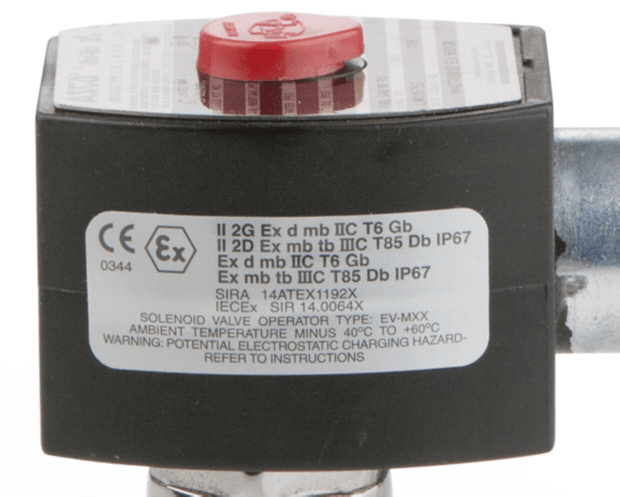
Figure 1: labels may have multiple T-codes to cover every real-world contingency
Conclusion
At first glance, the cryptic looking temperature codes printed on valve labels might seem confusing. However, using the simple explanations and pointers above, the buyer or specifier can easily select the correct ratings for a given valve and its intended application and location. Matching the right solenoid valve to the right environment helps ensure safe, efficient performance. Users can also help ensure compliance and reliable performance by making sure valves are properly tested. Query a prospective supplier about the development and testing regimen a given valve has undergone: Is it extensive? Does it test all production units, or only a few? Does it subject tested units to extreme conditions? Do tested conditions match those found on your sites?
Takeaways
- Where operating globally, seek solenoid valves with multiple T-code approvals
- Local agencies usually accept approvals from the top four agencies in North America and Europe (UL, CSA, ATEX, IECEx)
- If U.S. and Euro T-code ratings differ, select the lower rating that meets your site’s maximum ambient temperature
- For exceptionally low ambient temperatures and other special circumstances, consult Thorne & Derrick
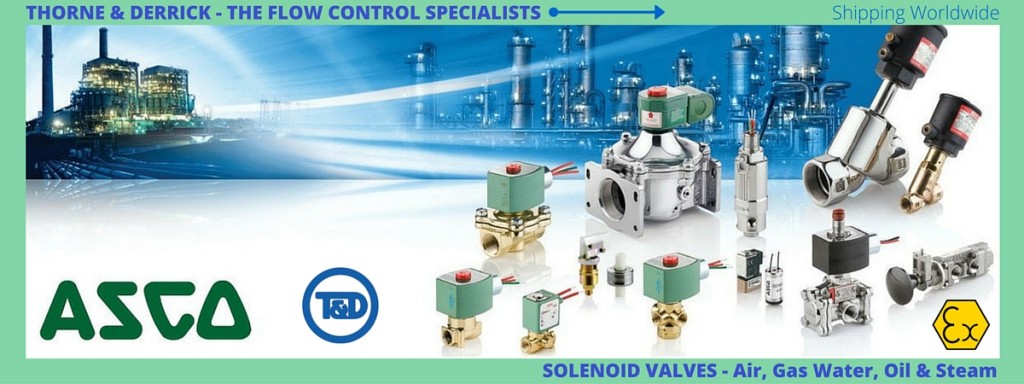
ASCO Valves

Explosive Atmosphere Experts
Thorne & Derrick are Specialist Distributors of Hazardous Area Electrical, HVAC & Process Instrumentation Equipment with IECEx & ATEX Certifications to the onshore and offshore oil, gas, petrochemicals and process industries.
We supply major UK and international infrastructure projects and also MRO (Maintenance, Repair, Operations) requirements for both planned and unplanned plant shutdowns – we react with a rapid response to customer demand to ensure downtime is minimised and reliable Power, Light & Heat is restored or provided.
We distribute Innovative products to manage the planned replacement of legacy equipment conformant with international classifications including ATEX and IECEx.
Key Product Categories: Control Panels | Plugs & Sockets | Isolators | Enclosures & Junction Boxes | Lighting | Control Stations | Motor Starters | Heat Trace Cables & Systems | Gas Detection & Detectors | Fire Detection & Detectors | Heat Detectors | Electrical Heating & Heaters
➡ Also Process Instrumentation Products: Ashcroft Pressure Gauges | ASCO Valves | Katronic Flow Meters | KROHNE Flow Meters | VEGA Level Sensors | Rotronic Temperature & Humidity Sensors

